The post Are you an apple or a pear? appeared first on Usana Health Sciences Organization.
]]>USANA ANZ Writer and Dietitian
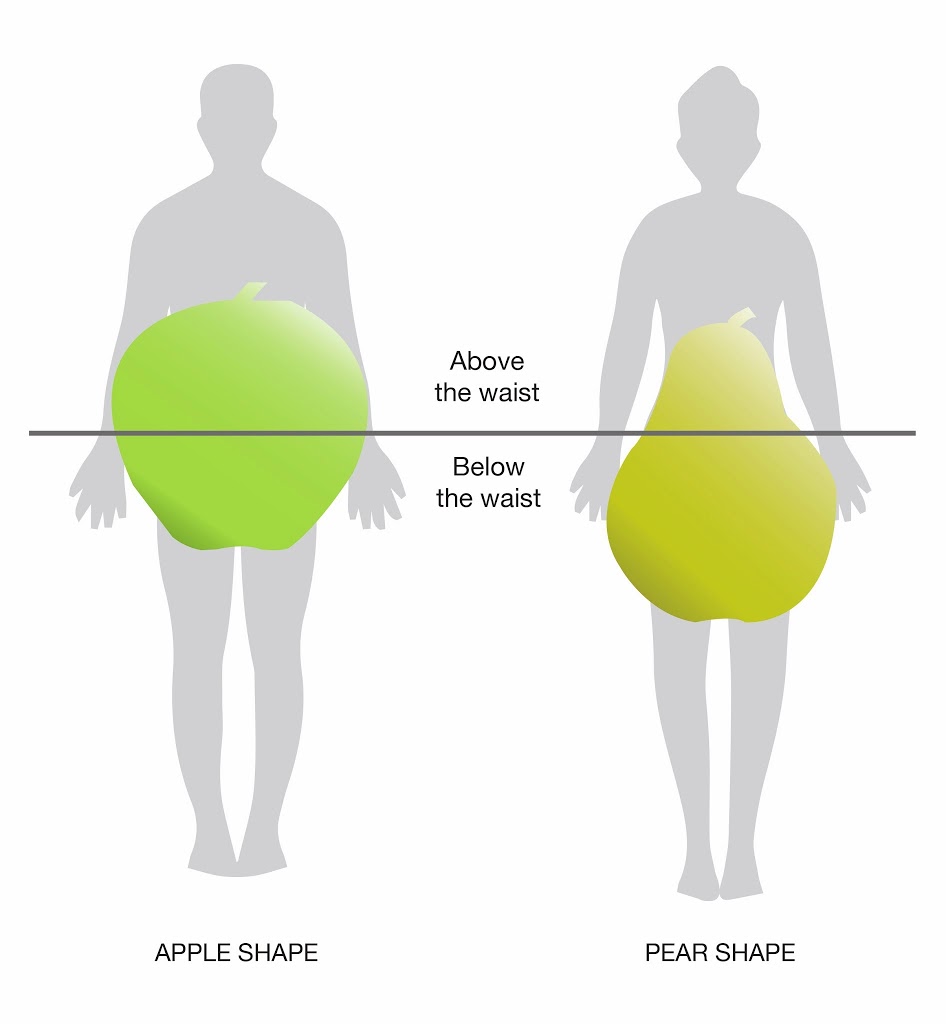 |
| Are you an apple or a pear? |
We’re getting heavier – there’s no doubt about that! And, if we carry on this way, then by 2025, nearly 80 per cent of adults will have a weight problem. Being too heavy has already overtaken smoking as the leading cause of premature death and illness in Australia. So are you ready for being overweight to be the new normal? Or are you prepared to do something about it?
Body facts
Being too heavy affects your body in many ways – it puts added pressure onto your bones and joints. It reduces mobility and it triggers fatty liver. It’s also a major cause of type 2 diabetes – a serious condition that if left uncontrolled can lead to nerve damage, amputation and even blindness!
And, getting into a healthy weight range today is the same as it ever was. You have to consume fewer calories and burn more. Plus, to maintain your weight, you have to make long-term, better health changes. Nothing new there…
Carrying too much weight wherever it is on your body is bad news. But more and more research is showing that carrying too much around your belly is particularly harmful. That’s because the types of fat that you’ll find on your bottom and thighs is slightly different to the type that’s found around your middle. Think of pear shaped versus apple shaped.
The fat in an apple shaped individual is called visceral fat (as opposed for subcutaneous fat that women around the world loathe and bemoan!). Visceral fat is much more active than subcutaneous fat. It is wrapped deep around the vital organs and it triggers the release of inflammatory chemicals. And since inflammation is behind problems with blood vessels – whether they are in the heart or the brain – it’s a good idea to reduce this type of fat particularly.
The healthy way to do this is to eat low-fat protein with every meal, increase fibre – especially from fresh fruit and veggies – whilst cutting down on saturated fat, sugar and salt (excess salt is linked with hypertension). It also very important to choose carbohydrates that are wholegrain (provide fibre) and have a low glycaemic index (GI).
Let’s talk GI
You probably already know that GI is a ranking system for carbohydrates. Low GI foods tend to be complex and take the body time to break down. They trigger the slow and steady release of glucose and help keep your body and mind fuelled for longer. They also help to keep you satisfied since a low blood glucose is what sets you running to the nearest vending machine!
Carbohydrates are ranked from zero to 100. So:
• Low GI = 55 and under (these are the best choice)
• Medium GI = 56-69 (choose these in preference to high GI foods and drinks)
• High GI = 70 and above (try to limit how much of these you consume).
You could say that high GI foods and drinks are already digested; the tiny sugar molecules are small enough to quickly enter your bloodstream. So, when your body detects that your blood glucose is raised (the body tries very hard to keep it within a normal range), the hormone insulin is released to reduce blood glucose levels and take the glucose into cells. The rapid surge in blood glucose after high GI eats and drinks mean that too much insulin is produced resulting in a sugar low. And it’s that low blood glucose that trigger the desire for yet another sugary fix. And so, the cycle continues…
More about metabolic syndrome
Being overweight and not being active can trigger metabolic syndrome and is also thought to contribute to central obesity (a cluster of symptoms that increase your chances of developing heart disease and type 2 diabetes) which is a major sign of metabolic syndrome.
Also called Syndrome X, metabolic syndrome is a condition that’s characterised by the production of large amounts of insulin which the body can’t use properly. Insulin tries to take glucose from the blood into body cells where it provides fuel for cell processes. And, by doing this, it helps to keep blood glucose levels within narrow concentrations. But when insulin can’t do its job properly, glucose circulates in the blood. This is insulin resistance when insulin is produced, but just can’t work as it should.
Your ethnicity and gender affect your likelihood of central obesity (more men are prone to it but women are more likely to get central obesity especially after menopause).
Generally speaking, if your waist measures 94 cm or more (men) or 80 cm or more (women), you probably need to lose some weight. If you are a man of South Asian, Chinese, Asian-Indian, Middle Eastern or Central American heritage, you are more at risk if your waist measures 90 cm or more. Recommended waist measurements are being investigated but because of typical body build, they are likely to lower for Asian men compared with Caucasian men and higher for people of Pacific Islander heritage.
So what can you do? Getting more active and enjoying a healthier lifestyle will help you lose excess body fat, and reduce your weight.
Cut the saturated fat
We already know that too much sugar and alcohol contribute to central obesity (hence the infamous beer belly!). It’s also well known that too much saturated fat is bad for your heart – it clogs up the arteries raising your risk of health disease and stroke.
Now, new research has shown another good reason to cut total fat and eat more unsaturated fat.It seems that too much saturated fat prompts the body to build more fat and less muscle compared with the same amount of calories from unsaturated fats. This study, published in the American journal, Diabetes , is the first research on humans to show that the saturated fat in foods doesn’t just influence cholesterol levels, it can also affect where fat is deposited. Researchers found that more fat was deposited in the abdomen and in the liver.
Fat in the liver and visceral fat both affect your metabolism – so this finding is especially important for people with conditions such as type 2 diabetes and for those who have a predisposition to them.
Unsaturated fats may regulate more energy burning or decreased storage of visceral fat when a person overeats. In other words, they switch on genes in visceral that are linked to reduced storage of fat and better glucose metabolism.
Exercise – regularly
Start slowly – try one, two, five minutes of skipping and build it up at your own pace until you can hop, skip or jump for half an hour. Remember, if you have any medical condition or if you haven’t exercised for a while, speak with your doctor first. An experienced personal trainer can help – or look for local classes in your area.
Start abdominal fat by working your whole core. Muscle exercises, such as working with weights, yoga and Pilates can help but blasting away total body fat with aerobic exercise is also very efficient.
Muscle takes up much less space than fat and it requires a lot more calories just to exist. So, increasing your muscle-to-fat detonates body fat and gives you great shape and definition. Work weight-training exercises into your weekly routine to build muscle – work towards two to three half-hour sessions per week and you’ll see the results fast!
Around 70 per cent of your weight is due to what you eat and drink and 30 per cent is down to how much and how well you exercise. So, watch your portion sizes, cut down on sugars and saturated fats, and watch what you drink. Juices, soft drink and alcohol are loaded with calories so be sure to be aware before you make the conscious decision. Drink lots of water as sometimes, it is easy to mistake hunger for thirst. Cut out fruit juices and sugary cordials etc.
Replace your meals with Nutrimeal
Kick-start your weight-loss by replacing all three meals for five days with a Nutrimeal. Yes, it can be a challenge. But it may be just the jump-start you need!
This kind of eating is the topic being research a lot right now. UK scientists funded by Diabetes UK found that drastically cutting calories in this way meant that overweight people who were taking medication for type 2 diabetes were able to stop using the tablets after two. Study participants consumed just 800 calories per day (each Nutrimeal provides around 230 calories so three Shakes plus one USANA Protein Snack provides around 850 calories). The researchers found that this low calorie diet helped the body to start to respond to its own insulin again.
Newcastle University’s Professor Roy Taylor believes that the benefits were seen when visceral fat was cut and so the body began to respond to insulin again. Visceral fat is thought to clog up the pancreas (where insulin is produced) and liver (which can get congested due to large amounts of triglycerides (a type of fat) from too much sugar/fat/alcohol). This cuts insulin production and stops insulin from being used properly.
By drastically dropping the calories, your body switches into starvation mode so that fat is burned from the vital organs. This frees up the organs so they can do their job properly again.
Remember to exercise for between 30-60 minutes a day to build lean muscle and burn more fat.
More about Nutrimeal
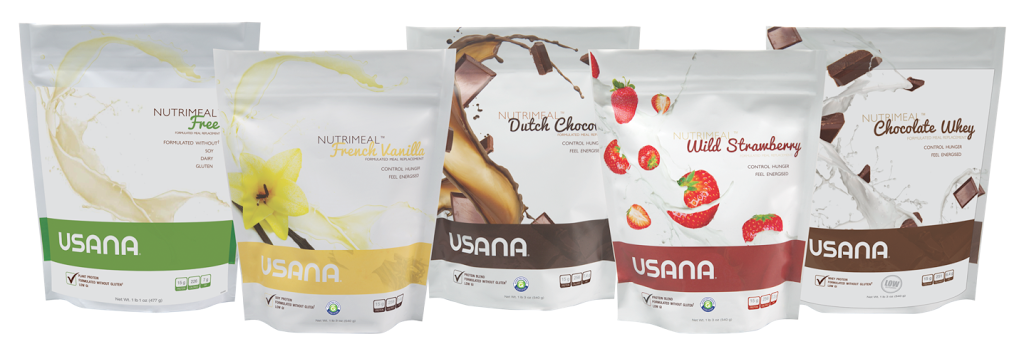 |
| Which flavour do you favour? |
Nutrimeal contains a range of proteins, healthy fats, low GI carbohydrates, vitamins and minerals – it’s a low calorie meal-in-a-glass. It’s a great choice if you want to drop some kilos or you want to focus on low GI eating (Nutrimeal has a glycaemic index of just 25 and is endorsed by the Glycemic Index Foundation. Check out the GI of foods on: www.gisymbol.com.au/foods.html) or you just don’t want to think about food and portions as you lose weight.
Try taking just Nutrimeal and a protein snack plus a piece of fruit and lots of steamed green veggies for five days. Then, switch to two Nutrimeal a day plus one low GI meal and healthy snacks until you achieve your weight-loss goals. Then, maintain your weight with one Nutrimeal daily, two healthy low GI meals and healthy snacks.
Other suggestions:
• Add extra fibre with a teaspoon or two of Fibergy Plus
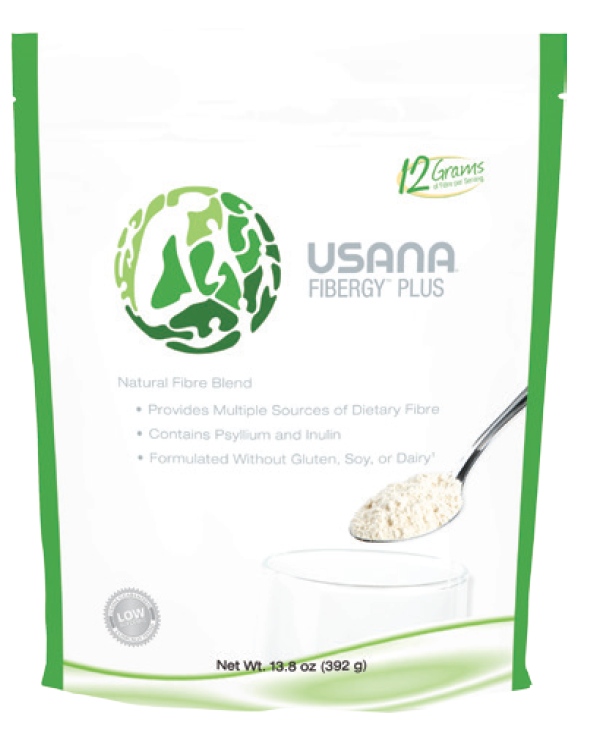 |
| Add the benefits of fibre |
• Add extra protein with SoyaMax
• Add USANA Probiotic to help your healthy bacteria flourish
• Try the liver health tonic, HepaPlus – it contains the liver tonic milk thistle and the potent anti-inflammatory, turmeric and choline to help your body metabolise fats
– it contains the liver tonic milk thistle and the potent anti-inflammatory, turmeric and choline to help your body metabolise fats
• Go Nuts’ n’ Berries – low in calorie snack (just 150 calories) made with nuts for healthy fats and super fruits (cranberries) plus a kick of vegetarian omega 3 (via chia seeds).
– low in calorie snack (just 150 calories) made with nuts for healthy fats and super fruits (cranberries) plus a kick of vegetarian omega 3 (via chia seeds).
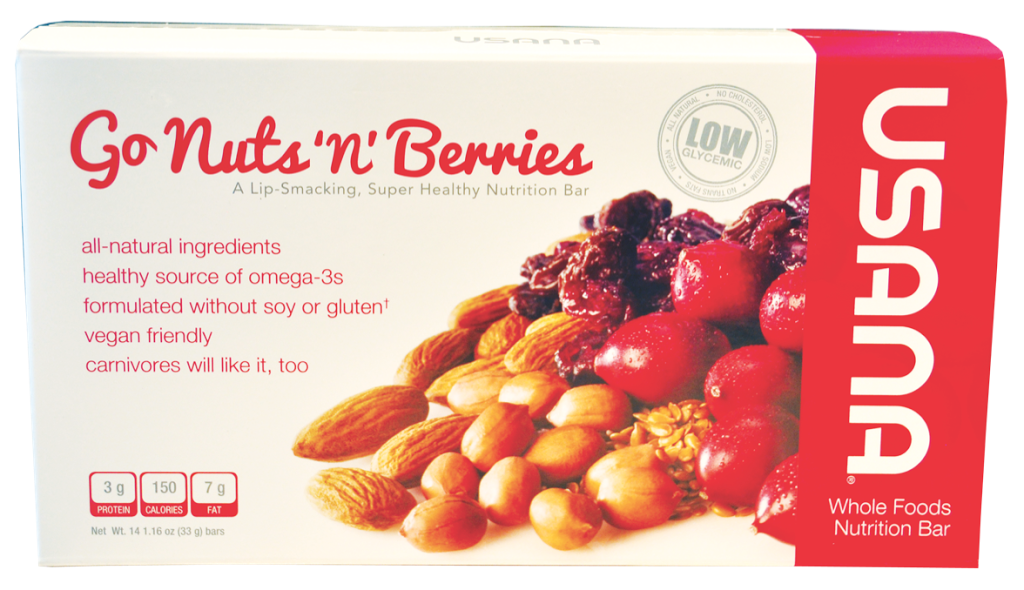 |
| With the goodness of nuts, berries and omega-3 from chia seeds |
The post Are you an apple or a pear? appeared first on Usana Health Sciences Organization.
]]>The post Six reasons to include exercise into your day appeared first on Usana Health Sciences Organization.
]]>Aiming for around 30 minutes of moderate activity on most days of the week, or 150 minutes of moderate activity over five or more sessions each week, is recommended for good health. Aerobic or cardiovascular exercise helps to protect your heart and improve endurance, build fitness, strength and stamina. Strength training (working with weights) tones and builds muscle for a lean and shapely figure. Getting both types of exercise is ideal – it will burn calories and help you manage your weight. It can also lift your mood so you’re more focussed than ever to get into a healthy, happy weight.
But, according to the Australian Institute of Health and Welfare, most of us are not moving as much as we should. More than seven out of ten of us don’t exercise enough. Here are just some of the reasons that you should move more!
Exercising regularly helps to:
1. Blast calories
You gain weight when you consume more calories than you use. Exercise is vital if you want to get lean and stay that way. But beware – unless your exercise is really intensive and you exercise for long enough, you may not be burning off as much as you think. For example, if you weigh around 60kg and you eat a 50g chocolate bar (270 calories) you’ll need to cycle at moderate pace for 35 minutes or walk for over an hour to burn it off! So, as well as burning off calories, thinking about what how much exercise you do and all those snacks and eats will help you to be more conscious about what you’re doing – and not be a distracted dieter!
2. Boost circulation
As you exercise, chemicals in working muscles produce substances that leave the muscle cells. These chemicals cause tiny capillaries (blood vessels) to dilate (widen) and this boosts blood flow which in turn brings more nourishing oxygen-rich blood to your working muscles. Better circulation helps to nourish your internal organs and skin cells, too, so you look better, too!
3. Support the muscles that support your joints
Regular exercise may help to slow down and even prevent problems with your muscles, joints and bones. Regular exercise helps to build and maintain strength and flexibility – important at every stage of life but especially as you get older.
4. Get in shape
Muscle and fat are two entirely different tissues and you can’t replace one with the other. But you can build muscle and reduce body fat with weight training and strengthening exercises.
Muscle burns more calories than fat because it is metabolically active i.e. it needs more fuel to exist rather than fat which is a storage material. Your body uses up fat stores when you exercise and build muscle. And, more muscle means more calories burned daily.
So, for every half a kilo of muscle you put on, you’ll automatically burn an extra 22 to 36 calories daily and you’ll have a sleeker, more shapelier shape.
Muscle and fat take up a different amount of space in your body, too. Take a look at 2.5kg of fat and 2.5kg muscle – when you have more fat, you can see clearly why you’ll have more wobbly bits!
You can target your problem areas – fat from around the exercising muscle is used for energy so you can firm up trouble areas. So if it’s your tummy that’s causing trouble, learn exercises that target your core.
Aim for strengthening exercises like weights at least twice per week for up to 30 minutes to slowly build up your body’s muscle. Oh and if you’re a woman, don’t worry that you’ll get too muscular by weight training – women don’t have enough testosterone to build as much muscle as men.
5. Perfect your posture, balance and coordination
Your posture is the way various parts of your body align in relation to one another. Good posture can help to prevent fatigue, headaches, eye strain, and chronic muscular tension. Getting your posture right can also help to boost circulation and even aid digestion. It might also help you sleep more soundly.
For good balance and coordination, you have to be able to control a number of muscles in order to prevent falling over. So, building your muscle strength leads to better balance and may even help to prevent injuries as with age.
6. Feel good about yourself!
According to the Black Dog Institute: ‘Numerous studies have shown that people who exercise regularly experience fewer symptoms of depression and anxiety than those who do not exercise regularly’. Also, ‘Several trials have shown that regular exercise of moderate intensity can be an effective treatment by itself for mild-to-moderate depression.’ That’s because exercise boosts the release of endorphins, the body’s natural painkillers and feel-good chemicals which in turn helps to boost your mood . And as regular exercise helps to tone and shape your body, you’ll have more reasons to feel good about yourself!
Aim for at least 30 minutes of moderate-intensity exercise on most days. Weight bearing exercise boosts your bone health as well as training your heart and lungs to be stronger. Swimming is an excellent low-impact exercise if you have a lot to lose or have stiff joints.
Include three sessions of strength training. The ultimate in sculpting your body, this flab fighter builds muscle and burns fat so you have a sculpted, leaner look. Plus, the more muscle you have, the faster your metabolism – i.e. the faster you burn calories.
So go on, get moving!
By Ravinder Lilly
USANA ANZ Writer and Dietitian
The post Six reasons to include exercise into your day appeared first on Usana Health Sciences Organization.
]]>The post You booze? You don’t lose! appeared first on Usana Health Sciences Organization.
]]>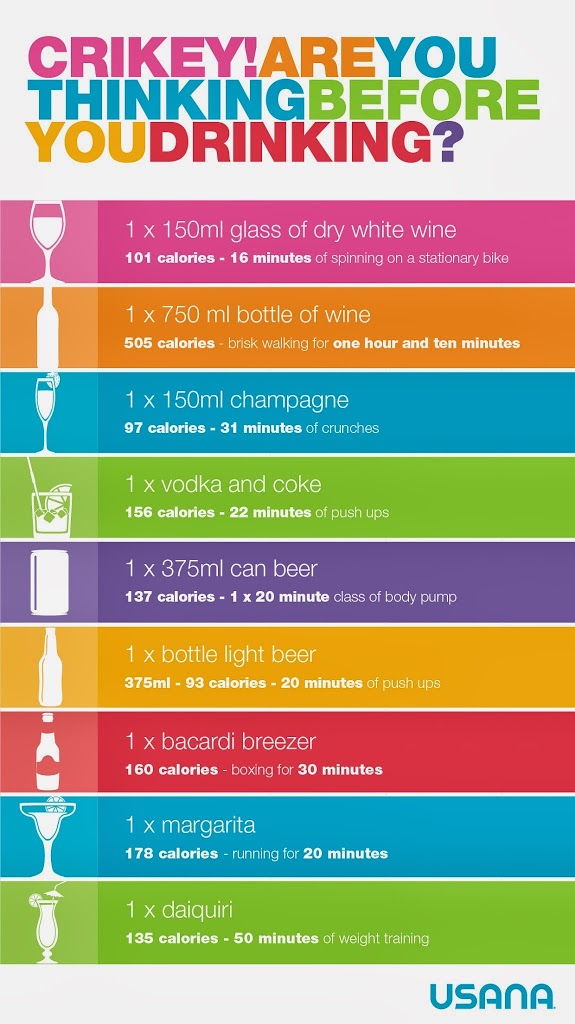
By Ravinder Lilly
USANA ANZ Writer and Dietitian
OK don’t get annoyed with me for this one. You asked for the truth and the whole truth and here it is… If you just can’t understand why you’re not shifting the weight, it could be due that alcohol is holding back your best made weight-loss plans.
Let me explain…
Many of us enjoy a drink or two. But when you’re trying to lose weight, you may find that it’s best if you lay off it completely – or stick to just one drink per day.
That’s because alcohol is loaded with calories. At seven calories per gram, it’s second only to fat (which provides nine calories per gram).
Plus, when you add in the mixers/juices, the calorie load rises even higher. Another reason that alcohol can crank up the kilos is that it’s easy to drink a lot of it without it affecting your body’s satiety system. So, the calories can pile up and up. Then, the dehydrating effects of alcohol increase your blood pressure and slow down your metabolism. But, where your weight is concerned, there’s even more bad news…
When your body detects alcohol, it responds to the introduction of what is essentially a toxin by switching from fat metabolism in order to focus on getting rid of alcohol from your body. So instead of breaking down fats, not just the fats you’ve just eaten but the fats in your body, it concentrates on ridding itself of alcohol.
Putting the brakes on fat breakdown
One small study published in the American Journal of Clinical Nutrition involved eight men who drank two units of vodka and sugar-free lemonade. Each drink contained just under 90 calories. Fat metabolism was measured before and after drinking and then for several hours afterwards. Results showed that fat oxidation in the whole body (a measure of how much fat the body is burning) dropped by a massive 73 per cent!
Incoming fat…
So, while your body puts the brakes on breaking down fats that are already in your system, alcohol is also notorious for weakening your willpower especially for fatty, salty snacks (kebab anyone?). The slowed-down fat metabolism combined with incoming fat means that it’s easy to store fat in your body and in particular, around your liver and centrally around your body. Hence the infamous beer belly.
Beer belly AKA central obesity
This kind of central obesity or apple shape raises your risk for raised blood fats, hypertension, cardiovascular disease and developing type 2 diabetes. Studies suggest that people eat around 20 per cent calories from food more than normal whilst drinking alcohol either because it interferes with your body’s ability to feel full or perhaps due to sheer will power weakening effects. The kind of fat around your middle is also metabolically active – it located deep inside your body and is wrapped around your internal organs. Plus, this type of fat prevents may hinder the work of your pancreas (which secretes insulin) and liver (which detoxifies and cleans your body).
Are you a weekend binger?
And, if you’re one of those people who is careful with alcoholic drinks during the week but lets it all happen at the weekend, you could be downing thousands of calories without knowing about it! So that cheeky glass of wine after work which turns into a couple. And the drinks with dinner. And so on. Unless you add up exactly what you drink (and eat) into a journal, you won’t have an accurate idea of what you’re consuming (try easydietdiary.com or myfitnesspal.com).
Seeing the calorie counts linked with drinks (just as more and more restaurants are doing for foods) – and the exercise that you’d have to do to work them off – may help to make us more aware.
Tips on controlling alcohol intake:
Women should drink less alcohol because their bodies don’t break down alcohol as fast because women are generally smaller than men and naturally have a smaller liver which processes and detoxifies alcohol.
You don’t need to cut out alcohol altogether. Once you’re at your healthy weight range, enjoy what you enjoy. But don’t overdo it.
• Alternate sugar-free soft drinks or water with an alcoholic one
• Go for light versions where possible
• Water down wine with sparkling water or diet lemonade for a refreshing spritzer
• Never eat without having food in your stomach
• Keep water available to quench your thirst while you drink alcoholic drinks.
Are you sticking to within the Australian Alcohol Guidelines?
Men: A max of two drinks a day on average with two alcohol-free days a week.
Women: Two or less drinks a day on average with two alcohol-free days a week.
A standard drink explained
1 standard drink = 10g alcohol which is equivalent to:
• 100ml of table wine
• 30ml of spirits
• 250ml of beer
But one drink isn’t always just one drink!
• An average restaurant serve of wine of 180ml 12% Alc./Vol = 1.8 drinks
• A 375ml can of full strength beer 4.9%Alc./Vol = 1.5 drinks
• A 375ml can of pre-mix spirits 5%Alc./Vol = 1.5 drinks
Check the label to find out how many standard drinks in your serve.
Cheers!
The post You booze? You don’t lose! appeared first on Usana Health Sciences Organization.
]]>
